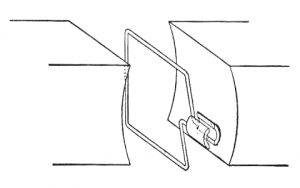How do power plants supply current to hundreds of houses? they even don’t utilize high capacity batteries. But this can be done by connecting a spinning a turbine to an electrical generator. Some power plants use extremely hot steam that blasts over the turbines as well as turns it or else uses the energy of the dropping water. one more example is windmills. The fundamental idea is that if you use an electric wire & move up or move down within the magnetic field then it makes an electric current. To attach a coil of wire and place it inside a magnetic field as the coil starts rotating, the wire starts moving up and down inside the magnetic field that produces the electric current these devices are called Electrical Generators. They convert mechanical energy into electrical.
Electrical Generator Definition
An electric generator is an instrument that changes the form of mechanical energy into electrical energy.
Who Invented Electrical Generator?
How does turning something create electricity, It was based on electromagnetic induction. Electrical Generator was invented by Michael Faraday more than 200 years ago.
Principle of Electrical Generator
An electric generator commissions on the principle of dynamically induced e.m.f. According to the electromagnetic induction principle at any time flux is cut by the conductor, dynamically induced emf will be advanced which causes a current flow in the conductor.
Flemings Right-hand Rule
The direction of the induced emf is found by Fleming’s right-hand rule which explains that stretch the fingers of the right-hand as that they at 90 degrees to each other. Then the thumb represents the direction of the motion of the wire, forefinger represents the direction of the magnetic field and the middle finger represents the direction of the current.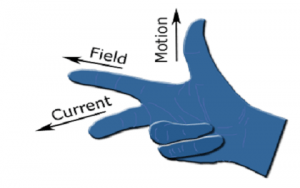
Working of Electrical Generator
- Consider a coil is made to spin in a magnetic field, then due to electromagnetic induction, a current gets generated in that coil. The direction of the current depends on whether the wire is going up or where it’s going down and as a result for every half a rotation.
- The wire that is going upwards the thumb should be pointing upwards the magnetic field, the forefinger should be pointing to the right and the middle finger is pointing inwards this means the current in the wire must be inwards.
- Similarly, for the wire moving downwards the thumb will be pointing down, the forefinger will still be pointing to the right and the middle finger is pointing out of the screen that means the current in the wire will be coming out of the screen.

- The current continues to flow as the coil keeps rotating because the wire is moving upwards and downwards. It changes its direction alternately while rotating inside a magnetic field. It reverses every time the coil is 90 degrees to the magnetic field, its direction will flip.
- If we connect the external circuit directly, the current will flow but as the coil starts rotating the wire starts to twist. To avoid this we attach the wires to metallic rings and carbon brushes which are also conducting. When the coil starts rotating the rings rotate along with the coil but since the brushes are not stuck to the rings they just slip through the brushes as slip rings.
- As a result, the brushes will not rotate which solves the problem of wires twisting. Now, for every half a rotation the current also reverses.
Different Types of Electrical Generators
There are two types of generator depending upon the direction of the current. They are
- AC generator
- DC generator
AC generator
- If we want to build an AC generator we attach the wires to metallic rings. These wires are connected to the carbon brushes which are also conducting.
- The current reverses each time the coil is at 90 degrees to the magnetic field, the current direction will flip. The current from the generator continuously changes its direction such a current is an alternating current or AC. As the director of the current keeps changing and this generator is an AC Generator.
Different types of AC Generators
- There are two types of AC generators. They are Induction generators and synchronous generators.
Advantages of AC generator
When you want to transmit electricity over a long distance like from the power station to houses then AC has some great advantages over DC and for that reason, the current that we get at our houses the electricity of our houses are all AC and these generators are AC generators.
- Transmission losses are less.
- Size is less compared to Dc.
DC Generator
- If we want to build a DC generator where the current direction does not change remains the same throughout. To maintain the current in the same direction the brush should come in contact with the wire by attaching split rings.
- Split rings as the name suggests is a ring that is split in between giving two half rings with some gap in between. DC generator the current flows in one direction through an external circuit and this arrangement which helps us automatically change contacts by Commutator.
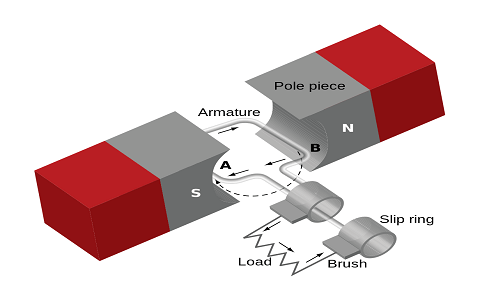
Working of DC Generator
- If we use split rings then it acts like a commutator and keeps changing the contacts every half a rotation. Here, the current does not change the direction in the external circuit and is referred to as a DC Generator.
Different Types of DC Generators
There are different types of DC generators. They are:
- Separately excited DC generators
- Self-excited DC generators
Self-excited generators are further classified as below
- Series Wound
- Shunt-wound
- Compound wound
Compound wound generators are further classified as below
- Cumulative compound wound
- Differential compound wound
The figure which depicts the classification of DC generators is shown below

Classification of DC generator
Depending on the arrangement of field winding generators are classified as separately excited and self-excited.
In a separately excited generator, the field winding is excited by some externally connected source. This external source helps the generator in inducing emf in the winding.
In a self-excited generator, the field winding is excited by its own source I,e by the generator itself. No other external source is required for the purpose of emf generation. So, this is the reason why it is termed as a self-excited generator.
A self-excited generator is further classified as series, shunt and compound wound based on the arrangement of its winding.
In the series-wound generator, the field winding is arranged in series with the armature as shown in the figure below.
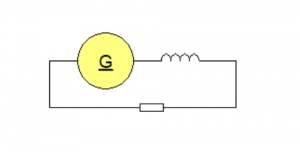
series generator
In the Shunt-wound generator, the field winding is arranged in parallel to the armature. So the circuit connection is illustrated below.
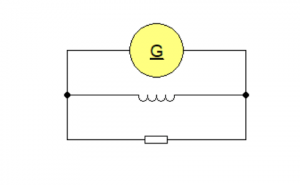
parallel generator
A compound wound generator is classified as a cumulative and differential compound wound. If series field winding aid with the shunt field winding then it is known as cumulative. If the series field winding opposes the shunt field winding then it is a differential compound generator. The figure which depicts Long shunt and short shunt generators are shown below.
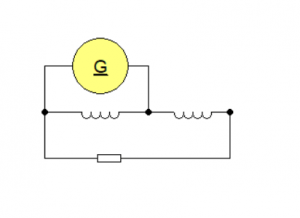
short shunt
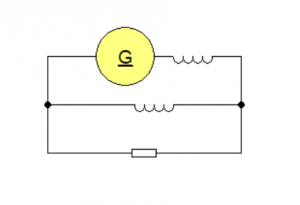
Long shunt
Advantages of DC generator
- Ease of parallel operation
- Simple design
- Dc generators charge batteries in the solar system.
- As current changes, the DC generator can change its speed accordingly.
Applications
- A dc shunt generator is used where stable voltage is required.
- Dc series generator is used as a booster.
- Compound generators are used Dc welding requirements.
Therefore, this article discusses an overview of the history, invention and generator definition. We have also studied the types of generators, Fleming’s right-hand rule and the working of the generator. Here is a question for you, what is the function of a commutator in DC machines?
